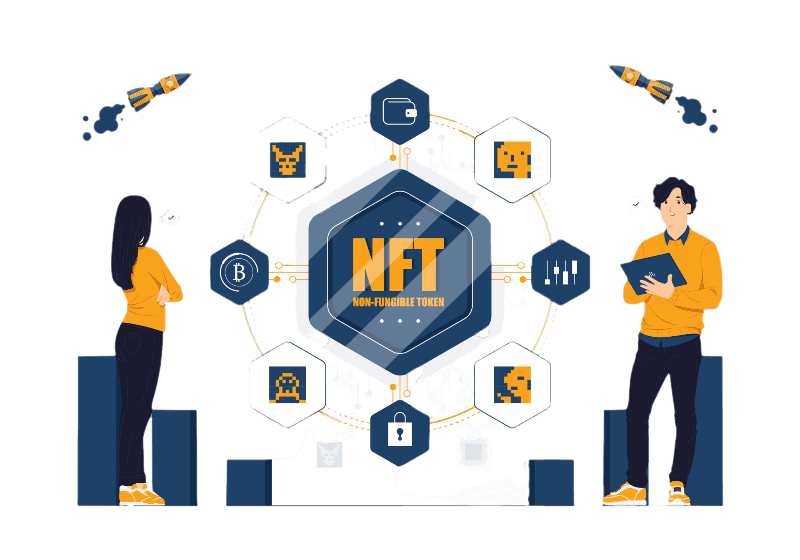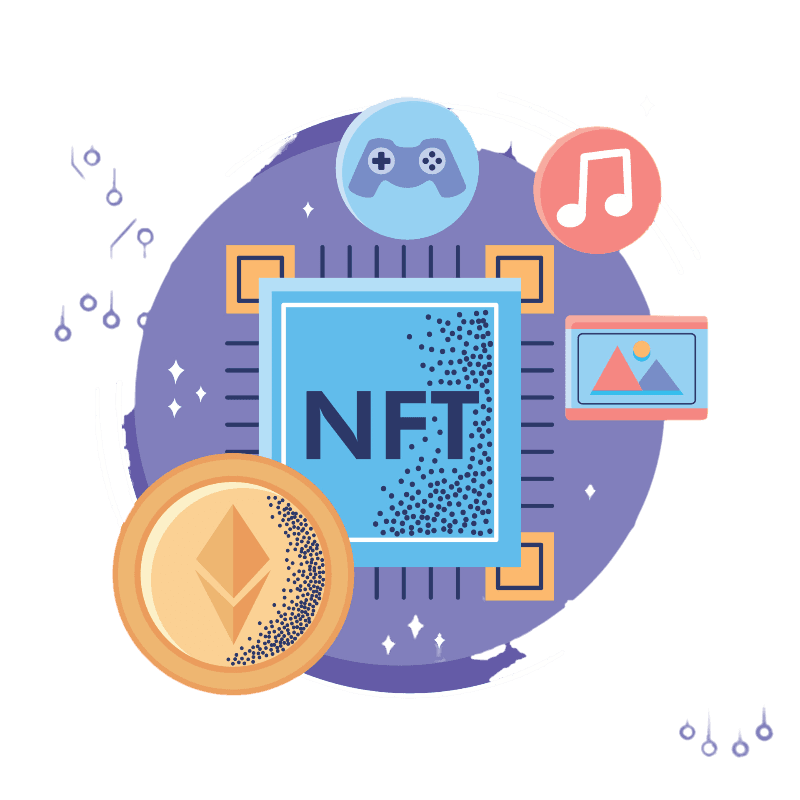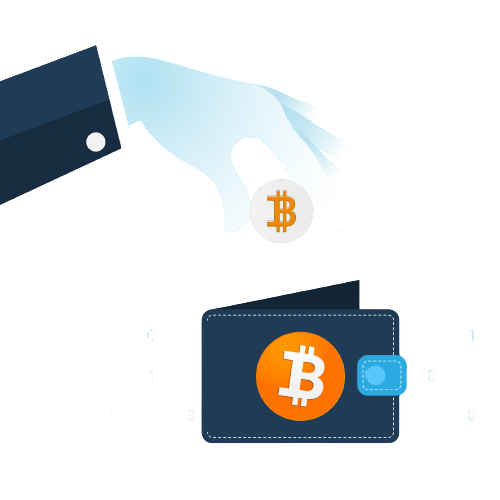
AI-generated NFTs represent the fusion of artificial intelligence (AI) and non-fungible tokens (NFTs). NFTs are unique digital assets that are indivisible and cannot be exchanged on a one-to-one basis like cryptocurrencies. Instead, they represent ownership of a specific piece of content, whether it’s art, music, virtual real estate, or any other digital creation. AI enters the equation by serving as the creative engine behind the content. Through the utilization of advanced algorithms like Generative Adversarial Networks (GANs) and Natural Language Processing (NLP), AI can produce intricate and unique digital works of art, music, and more. These AI-generated creations are then tokenized as NFTs, granting them provable scarcity and ownership on a blockchain.
Importance Of Integrating AI And NFTs With Cryptocurrency Wallets
The integration of AI-generated NFTs with cryptocurrency wallets creates a synergy that has significant implications for both the art and technology sectors.
Enhanced Ownership and Utility: By linking NFT ownership directly to cryptocurrency wallets, users have a consolidated platform to manage their digital assets. This integration allows collectors and investors to seamlessly store, trade, and showcase their AI-generated NFTs alongside their Bitcoin holdings.
Diversification and Innovation: The collaboration between AI and NFTs expands the possibilities of creative expression. Artists and developers can leverage AI algorithms to explore novel art forms and mediums, leading to a wider range of NFT offerings. This fosters innovation and attracts a diverse audience to the NFT ecosystem.
Security and Control: Integrating NFTs with Bitcoin wallets reinforces security. Bitcoin’s strong security practices can extend to the NFTs, safeguarding them from potential vulnerabilities in standalone NFT platforms. Users also maintain greater control over their assets by having them all in one secure location.
Simplified Transactions: The integration streamlines the process of buying, selling, and trading NFTs. Users don’t need to manage multiple platforms or undergo complex procedures; they can manage both Bitcoin and AI NFTs from a single interface.
Investment Synergy: Some investors in the cryptocurrency space see the potential for AI-generated NFTs to become valuable assets over time. Integrating these NFTs with Bitcoin wallets creates a unified portfolio strategy that merges traditional cryptocurrencies with innovative digital collectibles.
Understanding AI-Generated NFTs
A. Explanation of NFTs (Non-Fungible Tokens)
NFTs, or Non-Fungible Tokens, are unique types of digital assets that represent ownership or proof of authenticity of a specific item, piece of content, or collectible on a blockchain. Unlike cryptocurrencies like Bitcoin or Ethereum, which are fungible and can be exchanged on a one-to-one basis, NFTs are indivisible and distinct. Each NFT has a distinct value and cannot be directly swapped for another NFT at an equal value. This uniqueness is what makes NFTs suitable for representing digital art, music, virtual real estate, in-game items, and other forms of creative and collectible content.
B. Introduction to AI-Generated Content
Artificial Intelligence (AI) refers to the simulation of human intelligence processes by computer systems. AI-generated content involves using algorithms and machine learning models to create original works of art, music, text, or other forms of creative expression. These algorithms can analyze patterns, styles, and data to produce content that ranges from imitations of existing art to entirely novel creations. Machine learning techniques like Generative Adversarial Networks (GANs) and Neural Style Transfer have enabled AI to mimic artistic styles and even generate content that humans might find aesthetically pleasing or intriguing.
C. Emergence and Growth of AI-Generated NFTs
The integration of AI with NFTs has sparked a new wave of creativity and innovation in the digital art world. As AI algorithms improve and generate increasingly sophisticated content, artists, technologists, and collectors have recognized the potential to create unique digital assets that blend human creativity with machine intelligence. This fusion has led to the emergence of AI-generated NFTs, a category of NFTs that encapsulate the creative output of algorithms.
The Role Of AI In NFT Creation
A. How AI Contributes to the Creation of NFTs

Artificial Intelligence plays a pivotal role in the creation of NFTs by bringing innovation, automation, and uniqueness to the process. AI algorithms can generate content that goes beyond human capacity and imagination. This is particularly relevant in the context of NFTs, where uniqueness and scarcity are highly valued attributes.
B. Generative Adversarial Networks (GANs) for Art Creation
Generative Adversarial Networks (GANs) are a class of AI algorithms used in art creation. GANs consist of two parts: a generator and a discriminator. The generator creates new content, such as images or music, based on random input. The discriminator evaluates this content and tries to determine if it’s real or generated. The two components compete in a “game,” where the generator’s goal is to create content that’s so convincing that the discriminator can’t differentiate it from real content.
In the context of NFTs, GANs can produce art pieces that possess unique styles, themes, and forms. Artists and developers can influence the training of GANs, guiding the algorithm toward specific aesthetics. The resulting AI-generated art can then be tokenized as NFTs, enabling artists and collectors to participate in the ownership and trading of these novel creations.
C. Natural Language Processing (NLP) for Generating NFT Descriptions
Beyond the visual aspect of NFTs, Natural Language Processing (NLP) plays a role in enhancing the user experience associated with NFTs. NFT marketplaces often include descriptions of the artwork, music, or collectibles being offered. NLP algorithms can assist in generating these descriptions by analyzing the content and crafting compelling narratives that provide context and meaning to potential buyers.
NLP-powered descriptions can help create emotional connections between the NFT and potential buyers, adding value and depth to the NFT itself. AI-generated descriptions are particularly useful when artists may not be available to provide detailed explanations for each piece they create.
D. Enhancing Scarcity and Uniqueness with AI Algorithms
Scarcity and uniqueness are fundamental aspects of NFTs that contribute to their value. AI algorithms can enhance these attributes by creating genuinely one-of-a-kind content. Whether it’s a digital artwork with a style never seen before or a piece of music that combines genres in a novel way, AI-generated content has the potential to break away from the familiar and offer collectors something entirely new.
AI’s ability to create content at a scale and complexity that surpasses human capabilities contributes to the creation of NFTs that are truly scarce and unique. By harnessing AI, creators can push the boundaries of creativity and provide collectors with assets that are unparalleled in their distinctiveness.
Benefits And Challenges Of AI-Generated NFTs
A. Benefits
1. Increased Diversity of NFT Content
AI-generated NFTs introduce a wide array of content that might not be achievable through traditional human artistic processes alone. The limitless possibilities of AI algorithms mean that artists can experiment with various themes, styles, and concepts, enriching the NFT ecosystem with a diverse range of creations.
2. Accelerated Creation Process
AI can significantly speed up the content creation process. While artists might take hours, days, or even longer to produce a single piece, AI algorithms can generate multiple pieces in a fraction of the time. This rapid production rate can cater to the growing demand for NFTs while maintaining a level of uniqueness.
3. Exploration of New Artistic Styles
AI allows artists to explore and experiment with styles that might not be within their traditional skillset. This opens doors to the fusion of different art forms, leading to the birth of entirely new and innovative styles that can captivate audiences.
B. Challenges
1. Ethical Concerns and AI Authorship
The question of who should be credited as the author of AI-generated content poses ethical challenges. While AI is a tool used by artists, it’s the algorithm that generates the content. Determining authorship and the fair distribution of proceeds can be complex, raising questions about intellectual property, copyright, and artistic integrity.
2. Quality Control and Algorithm Biases
AI-generated content isn’t immune to errors or flaws. Ensuring consistent quality and creativity in AI-generated NFTs can be a challenge. Moreover, AI algorithms can inherit biases present in the training data, leading to potential issues related to representation and diversity in the content.
3. Balancing Human Creativity with AI Assistance
Finding the right balance between human creativity and AI assistance is crucial. While AI can aid artists in generating content, it’s essential to retain the unique touch of human creativity that resonates with audiences. Over-reliance on AI might result in art that lacks the depth and emotional connection that human-created art can provide.
4. Preservation of Artistic Intention
AI-generated NFTs may sometimes lack the intention and emotional depth that human artists infuse into their work. The emotional and intellectual context behind traditional art might be absent in AI creations, which could impact the way collectors perceive and value art.
5. Consumer Perception and Value
The rapid generation of AI NFTs could potentially lead to oversaturation, where the value of individual pieces might decrease due to the sheer volume of available content. Collectors might become more selective about the AI-generated NFTs they choose to invest in.
Integration Of AI-Generated NFTs With Bitcoin Wallets
A. Exploring the Integration Concept

The integration of AI-generated NFTs with Bitcoin wallets involves merging two distinct yet complementary elements of the digital landscape. By linking NFT ownership to cryptocurrency wallets, users gain a unified platform to manage both their Bitcoin holdings and AI-generated NFTs. This integration leverages the security, convenience, and functionalities of cryptocurrency wallets to enhance the NFT experience.
B. How NFT Ownership Is Linked to Cryptocurrency Wallets
NFT ownership is typically associated with a unique digital wallet address on a blockchain. This address acts as a digital fingerprint for the NFT, verifying ownership and enabling transactions. Integrating NFTs with Bitcoin wallets involves associating NFT ownership with the same wallet address used for holding Bitcoin or other cryptocurrencies. This consolidated approach streamlines the user experience, allowing individuals to manage, trade, and interact with both assets from a single wallet interface.
C. Benefits of Integrated Platforms for Collectors and Investors
1. Unified Asset Management
The integration provides a centralized platform for users to oversee their AI-generated NFTs and Bitcoin holdings. This streamlines the management process, eliminating the need for multiple apps or platforms and offering a more cohesive experience.
2. Enhanced Security
A Bitcoin wallet is built with robust security features to safeguard users’ cryptocurrency holdings. Integrating AI-generated NFTs into the same wallet extends this security to NFTs, protecting them from potential vulnerabilities that could exist on standalone NFT marketplaces.
3. Simplified Transactions
Integrated platforms allow users to seamlessly perform transactions involving both Bitcoin and NFTs. This simplifies the process of buying, selling, or trading assets, eliminating the need to transfer funds between different accounts or platforms.
4. Portfolio Diversification
Investors can diversify their portfolios by seamlessly including AI-generated NFTs alongside traditional cryptocurrencies. This enables them to explore alternative investment avenues within the same trusted environment.
5. Monitoring Value
Investors can conveniently track the value of their AI NFTs alongside their Bitcoin holdings, enabling better-informed decisions based on the overall performance of their digital assets.
6. Accessibility and Adoption
The integration might attract individuals who are already familiar with Bitcoin and cryptocurrency wallets, making the concept of AI-generated NFTs more accessible to a wider audience.
7. Future-Proofing Investments
The integration anticipates potential future scenarios where AI-generated NFTs gain value and recognition as valuable assets. By keeping these NFTs within established wallets, investors ensure that their assets remain secure and easily accessible.
Technical Implementation And User Experience
Integrating AI-generated NFTs with Bitcoin wallets requires a technical framework that links the ownership of NFTs to the same wallet addresses used for holding Bitcoin. This can involve creating smart contracts on the blockchain that tokenize AI-generated NFTs and associate them with the user’s wallet. This linkage enables seamless transactions and interactions with NFTs directly from the wallet interface.
The integrated platform should offer visual representations of the user’s AI NFT collection and its associated values, much like portfolio tracking for traditional investments. This could include graphs, charts, and relevant statistics to help users monitor the performance of their assets over time. Additionally, users should be able to see their Bitcoin balance and value alongside their NFT holdings.
Investment Potential
Both AI-generated NFTs and Bitcoin have captured the attention of investors due to their potential for high returns. AI NFTs present an opportunity to own unique digital assets with creative and speculative value, while Bitcoin is often seen as a store of value and hedge against traditional markets. The integration of the two creates a hybrid investment approach that combines the characteristics of both assets.
Security Considerations
Security measures should address potential vulnerabilities arising from combining different types of assets within a single platform. Thorough testing and audits are essential to identify and rectify security risks before the integrated platform goes live.
Integration increases the surface area for potential attacks. Robust encryption, multi-factor authentication, and constant monitoring are vital to safeguard both Bitcoin and AI-generated NFTs from unauthorized access and breaches.
Private key management is pivotal in securing both Bitcoin and AI NFTs. Users must understand the significance of keeping their private keys safe, as they grant access to their assets. Educating users about best practices and providing user-friendly key management solutions are critical aspects of maintaining security.
Future Innovations And Possibilities
Integration could evolve to include more advanced features, such as AI-driven recommendations for NFT purchases based on user preferences and behavior. The platform might also allow users to create their AI-generated NFTs directly from the wallet interface, blurring the lines between creator and collector.
AI algorithms could be used to analyze market trends, sentiment, and user behavior to provide predictive analytics for NFT investments. This could assist users in making informed decisions about buying, selling, or holding AI-generated NFTs.
Ethical Implications And Conclusion
The integration of AI-generated NFTs brings forth ethical considerations about authorship, originality, and the role of human creativity in the creative process. Addressing these concerns is essential to ensure fair recognition for both AI creators and traditional artists.
As AI plays a significant role in NFT creation, fair compensation and acknowledgment for AI creators become important. Mechanisms for attribution and revenue-sharing must be established to avoid issues of exploitation.
The intersection of AI, NFTs, and cryptocurrency wallets presents an exciting frontier. The integration bridges technology and art, enabling a synergistic ecosystem where digital creativity and financial innovation thrive. As these fields continue to evolve, stakeholders must collectively navigate challenges and seize opportunities to shape a dynamic and promising future.